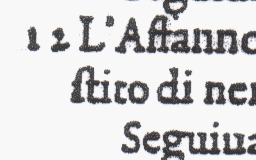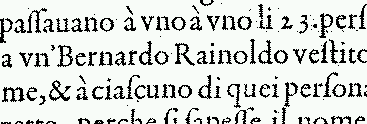
Berkeley, page 209

LoC, page 209
[See also: The editions of Cesare Negri's Le Gratie d'Amore: Choreographic revisions in printed copies]
This manual was typed from Yvonne Kendall's D.M.A. thesis (which has a facsimile of the UC Berkeley library's copy of the 1602 edition), and was proof-read against the U.S. Library of Congress copy (1604 edition). In the process of proof-reading, a few differences were found between the editions. It is clear that almost all of the pages were reused verbatim in 1604, with a new title page stuck on the beginning. In addition to these two copies, a 3rd copy (from the Bibliothèque Nationale de France, 1604 edition, called BN), a 4th copy (the Broude Brothers facsimile, 1602 edition, called BB), and a 5th copy (1604 edition, in the Richardson Collection, labeled "Biblioteca Apostolica Vaticana" at the end, called RC) were spot-checked against known differences.
 Berkeley, page 209 |
 LoC, page 209 |
 Berkeley, page 210 |
 LoC, page 210 |
There are also some smaller differences. Page 10, 3rd line begins with "stito" in Berkeley and BB (1602), and "sti to" in the LoC and B.N. (1604) copies. It's unclear if this is a paste-in, or was corrected in the middle of the run of this page.
 Berkeley |
 LoC |
 Berkeley |
 LoC |
The second is on page 213 (Adda Felice, not the other page 213 at the start of Alta Mendozza), where the Berkeley 1602 copy dedicates the dance to "Beatrice" in a different font from the surrounding words, while one 1602 copy (BB) and both 1604 copies (LoC and B.N.) have "Isabella d'", in a font similar to the surrounding words.
In the dance Laura Gentile, Jones makes a comment about differences on the two reprinted pages. The symbols that Negri uses to indicate passo grave and passo puntato are quite similar: the second has a dot above the P. However, the vertical placement of the P is also different; the second has a P which descends below the line. All 4 copies of the book that I looked at have a descending P; two have the dot on top (BN, LoC, both 1604) and two appear to be missing the dot (BB, Berkeley, both 1602). Since Jones claims that the Broude Brothers facsimile contains the error, I suspect that she noticed the missing dot without noticing the descending P. It is somewhat surprising that these two pages were reprinted, when a single mark with a pen would have fixed them.
| This image shows the descending P with 3 dots (passi puntati) and non-descending P with 2 dots (passi gravi). |  |
In the dance Alta Visconte, all 4 of these copies have the version which Jones says is a paste-in.
Return to Negri's Dance Manual.
Revision history:
1.0, Nov 30, 2002: Initial version.
1.1, Dec 7, 2002: Added some gifs, noticed that the 2nd paste-in is on the other page 213.
1.2, May 19, 2003: Added 2 more copies, and notes about Jones. 1.3, March 1, 2011: Clarified that only a new title page was added in 1604. Fixed spelling of "bell'ingegno" and "Bernardo". Added note about Richardson 1604. Thanks are due to Katherine Tucker McGinnis for drawing my attention to these issues.
Gregory Blount of Isenfir (lindahl@pbm.com)